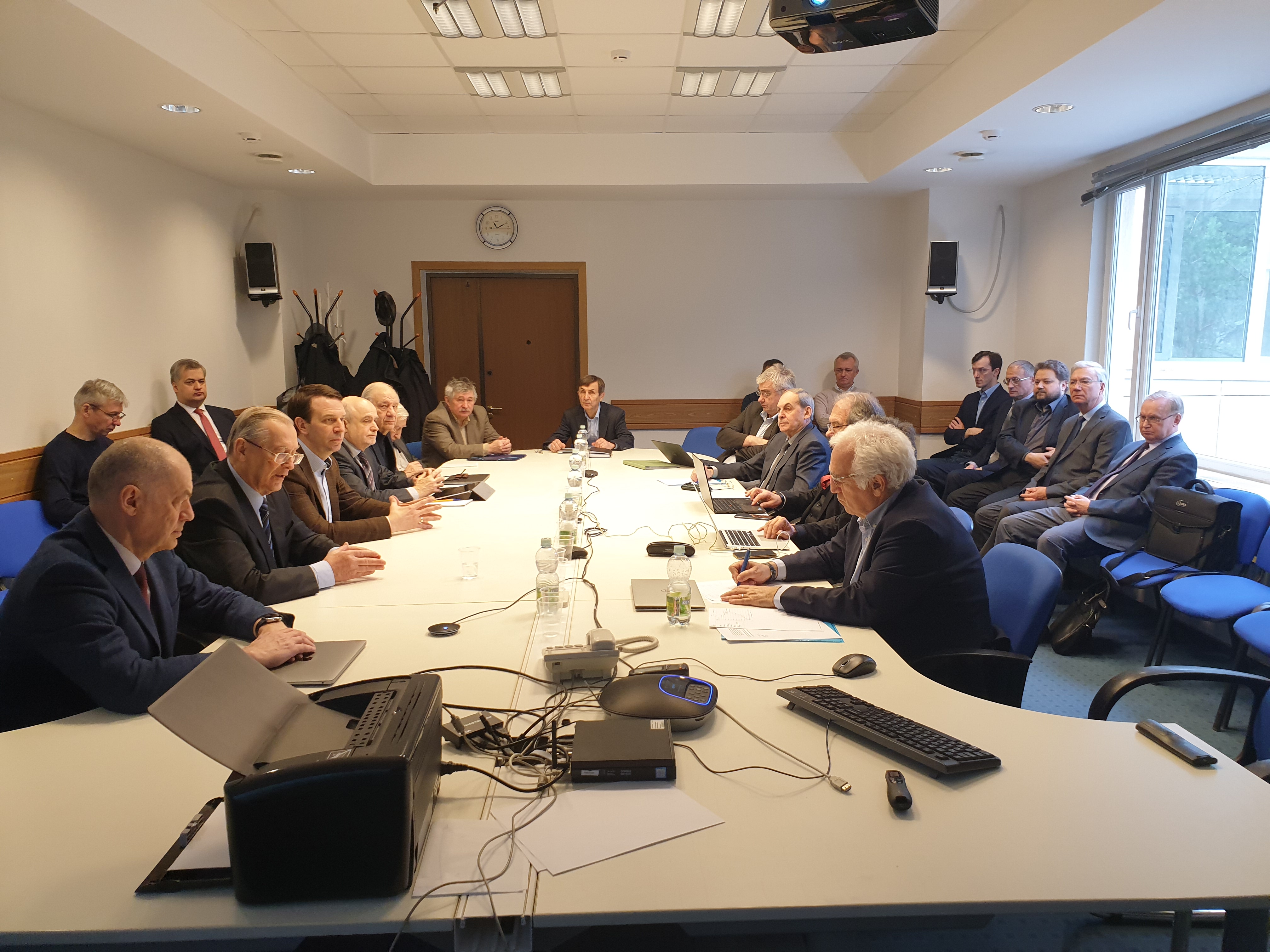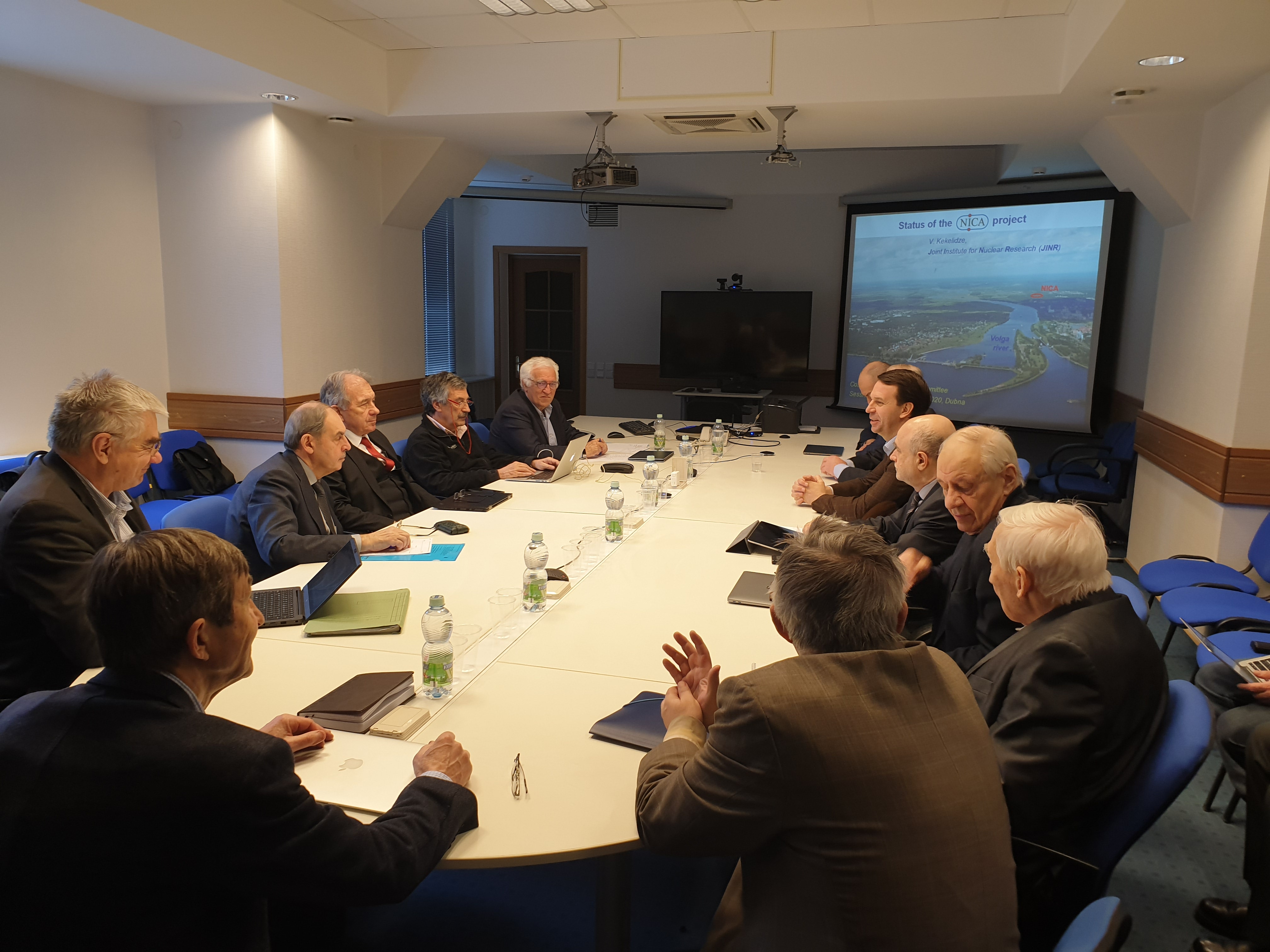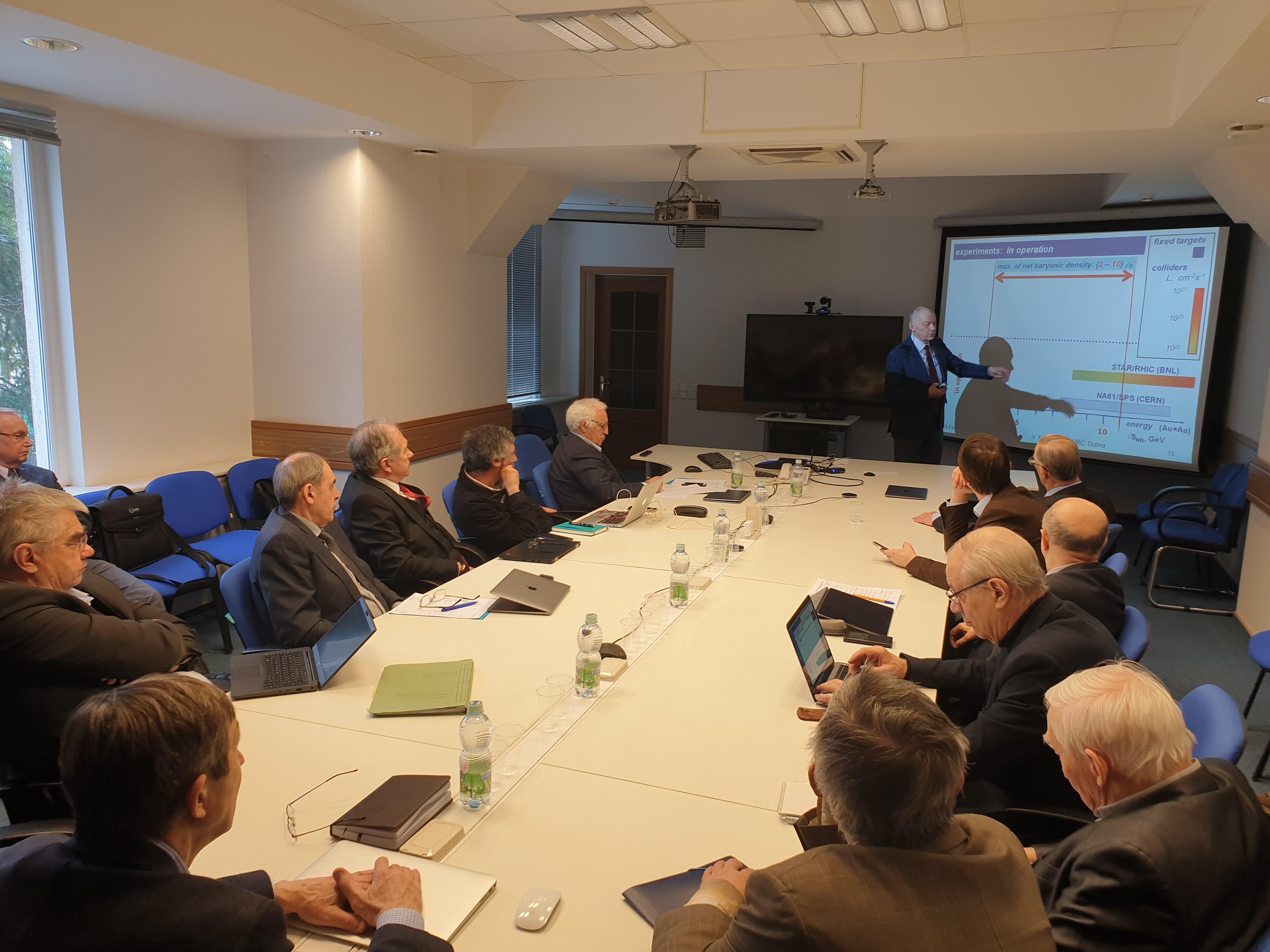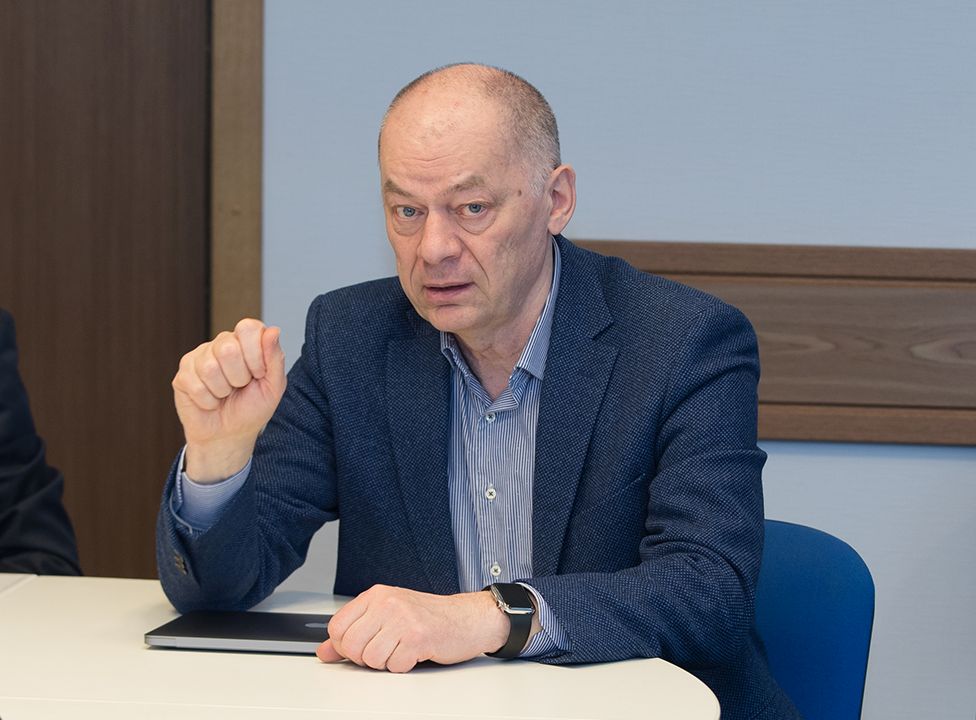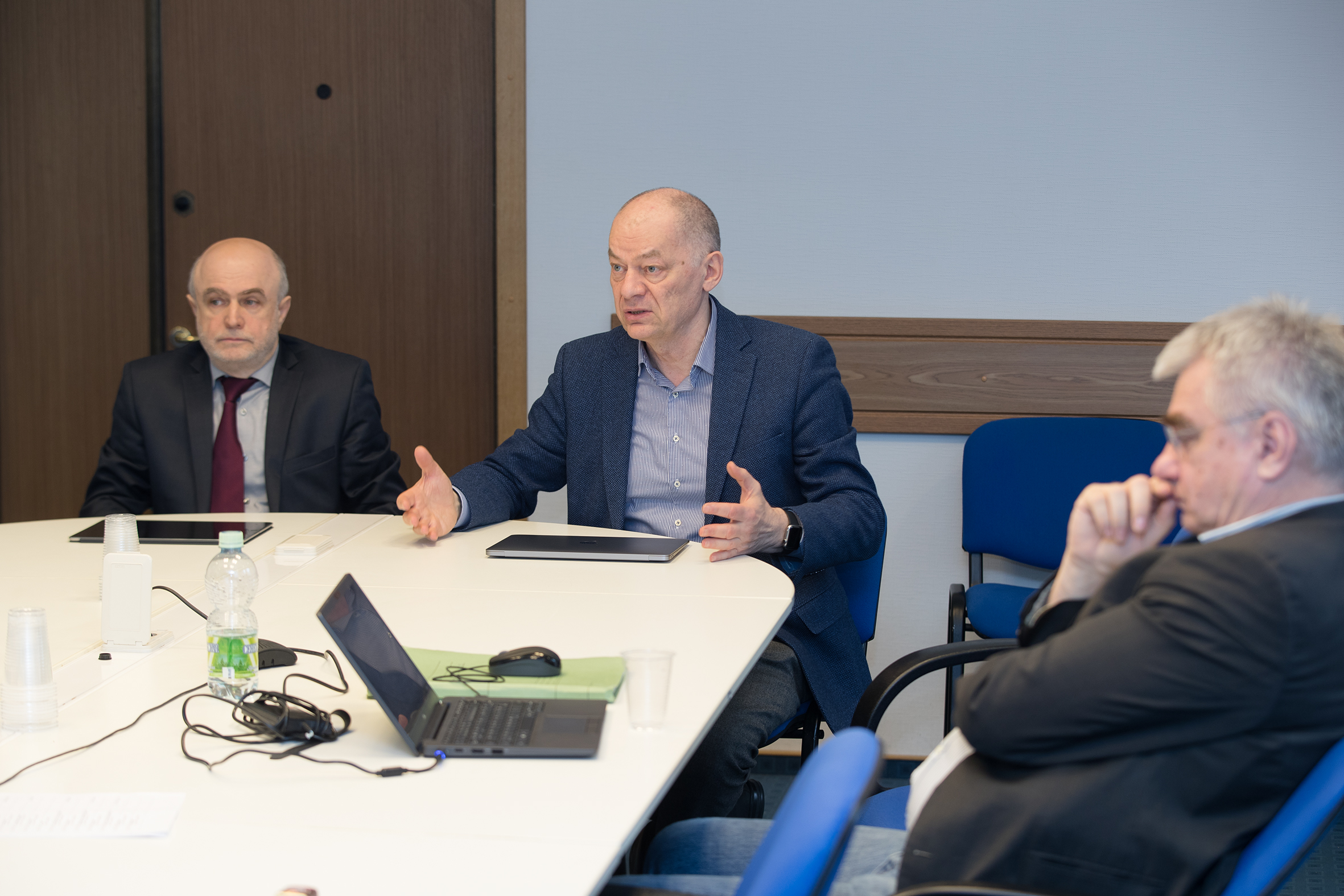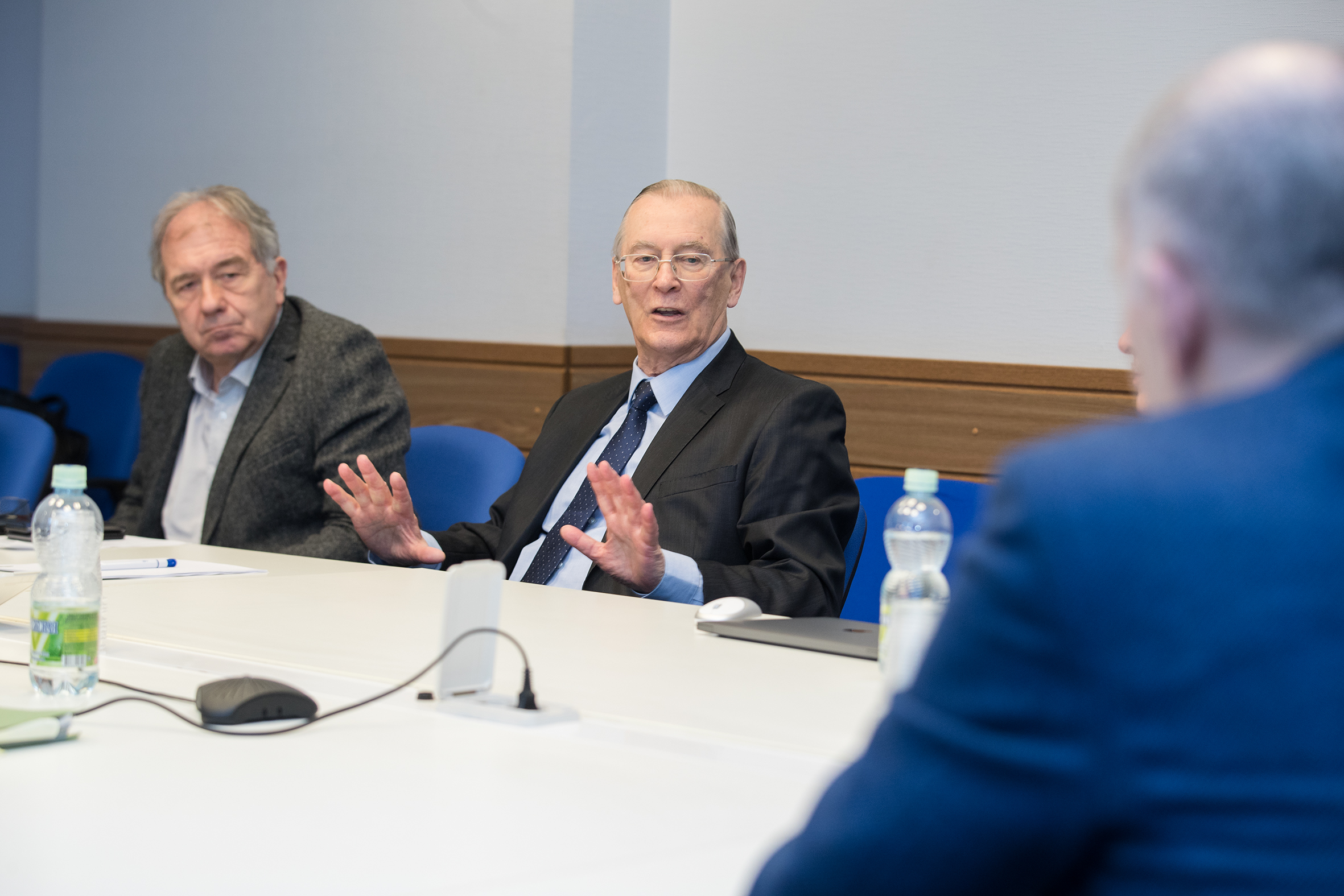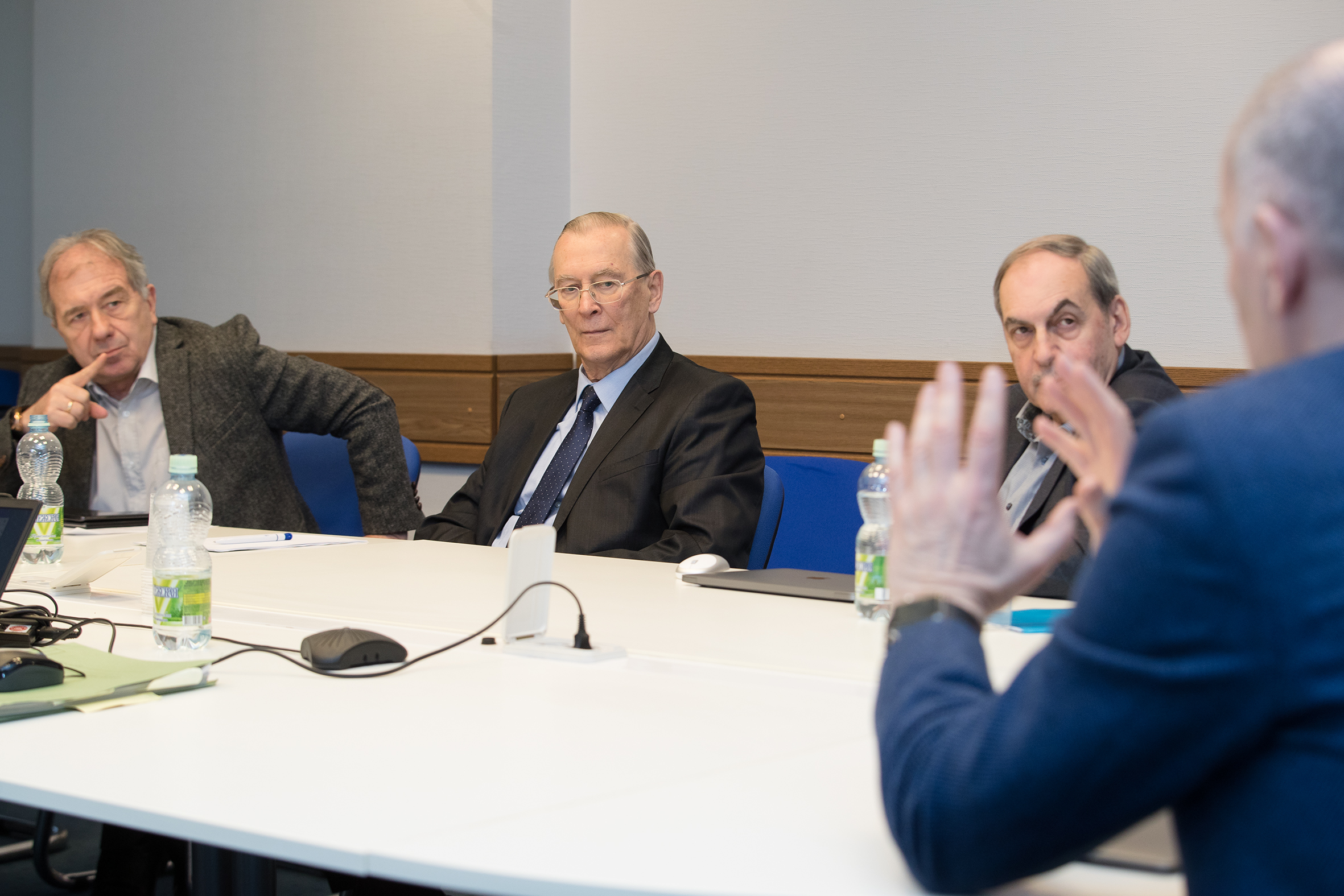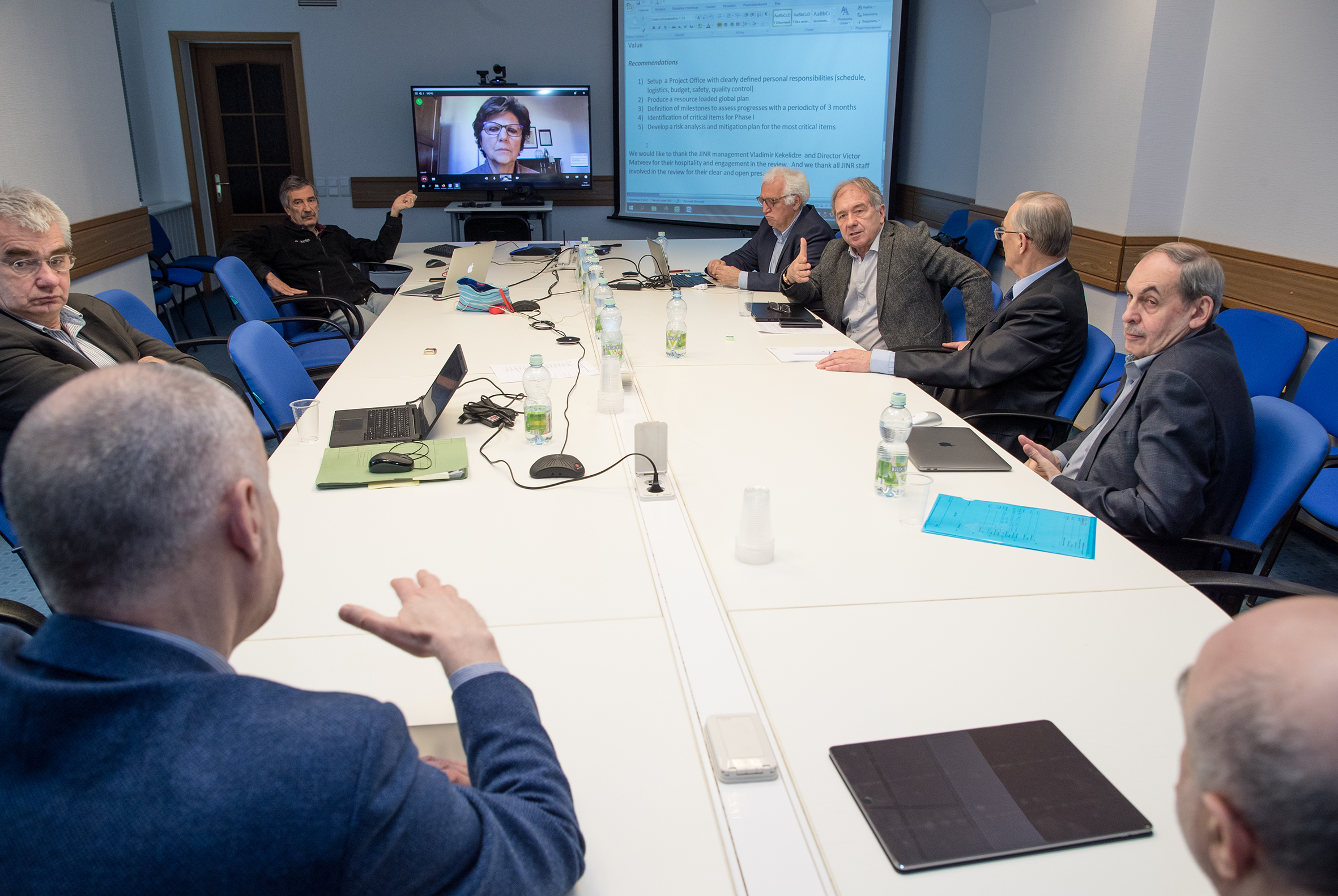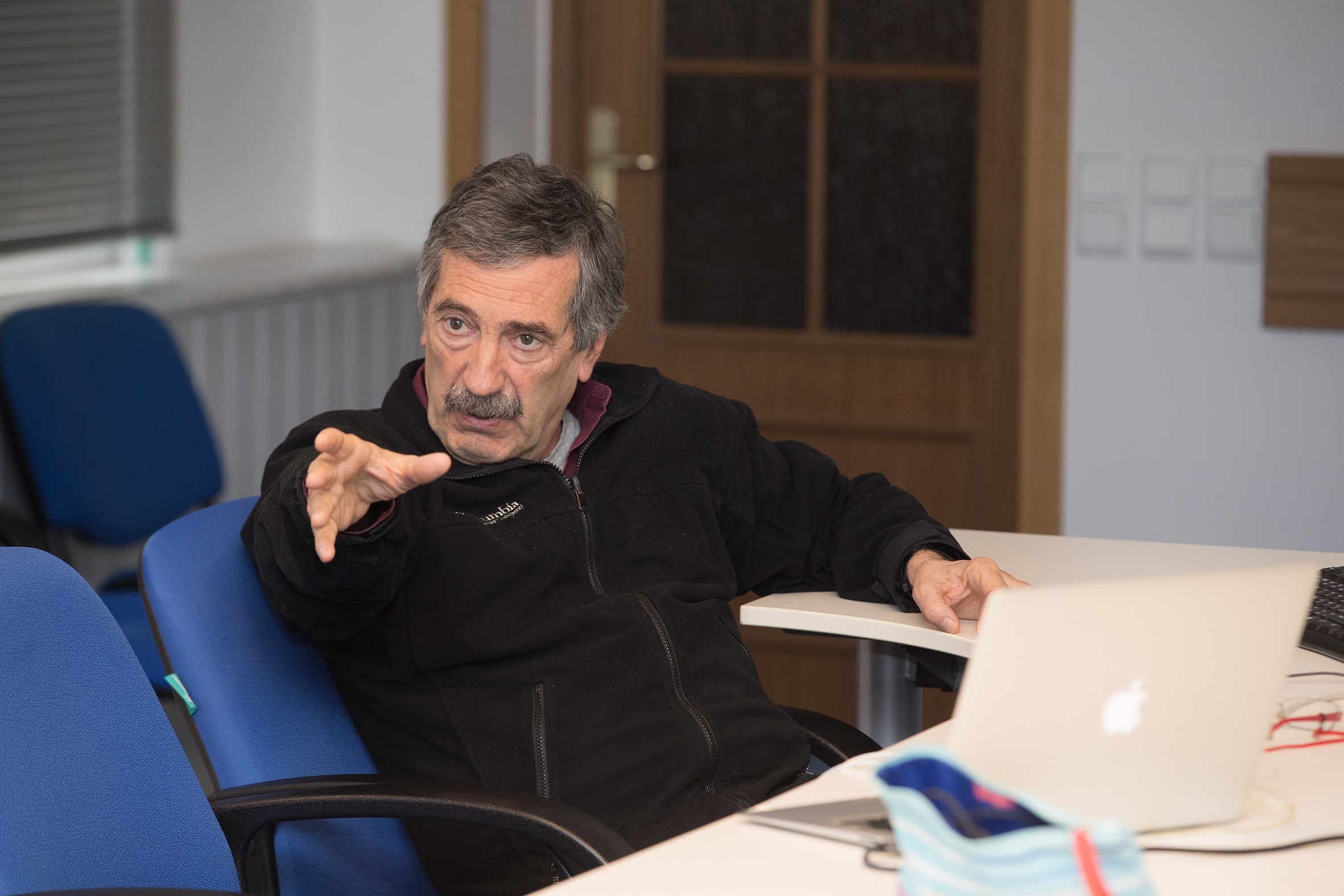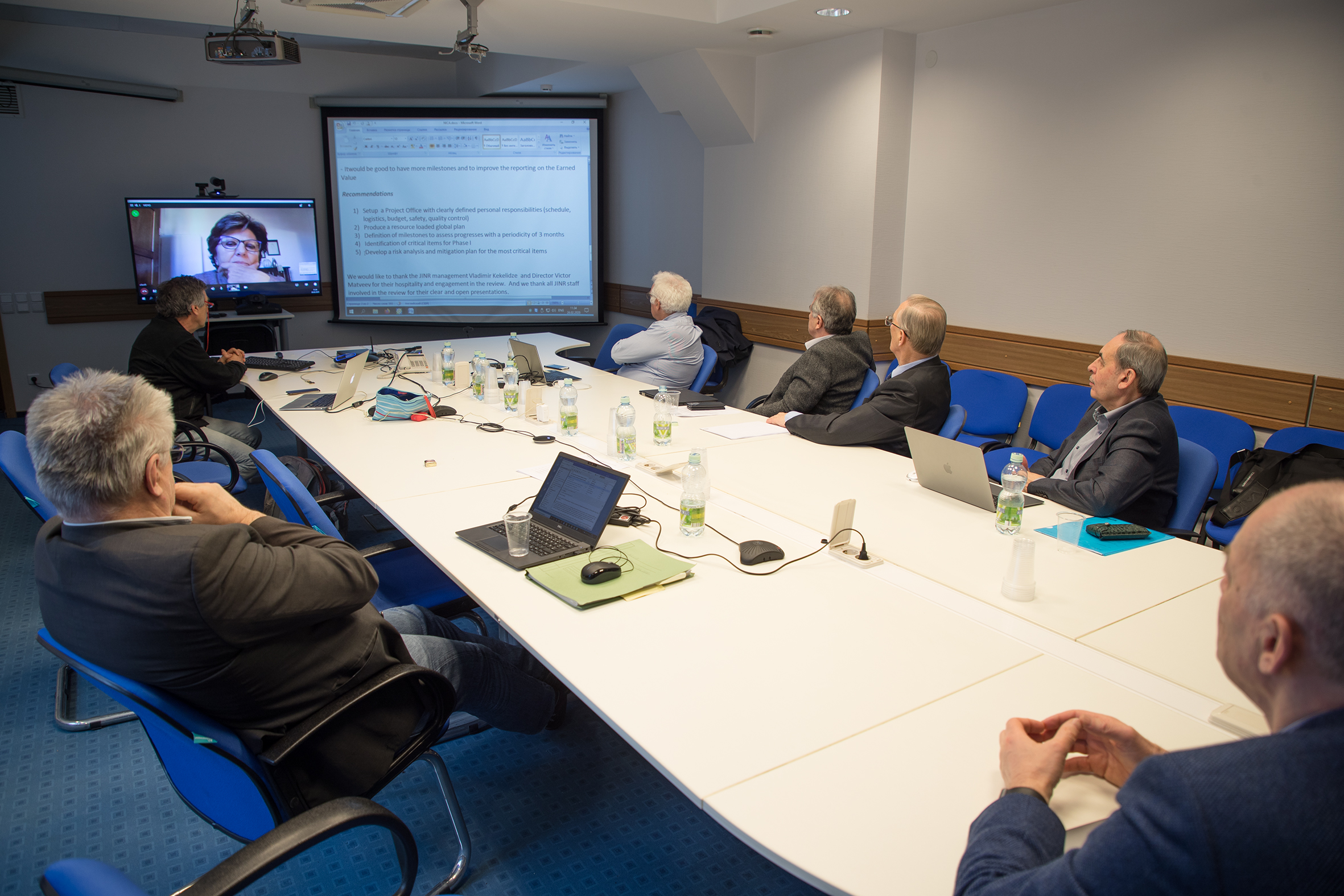NICA: Cost and Schedule Review Committee started its work
News, 05 March 2020
On 24 – 26 February 2020, the first meeting of the NICA Cost and Schedule Review Committee (CSRC) was held. The Committee emerged on the decision of the Committee of Plenipotentiary Representatives of the Government of the JINR Member States and the Supervisory Council for the project “NICA complex”.
The aim of the Committee is to consult the Supervisory Council and the CP on issues related to cost estimate and work progress towards the implementation of the NICA project. The Committee headed by Fernando Ferroni (INFN, Italy) consists of six more specialists in the fields of high energy physics and accelerator physics. First Deputy Minister of Science and Higher Education of Russia G. V. Trubnikov took part in the first day of the CSRC meeting. All the meetings of the Committee were attended by JINR Director V. A. Matveev, Head of the project “NICA complex” V. D. Kekelidze and Co-Head of the theme “NICA complex” A. S. Sorin. Head of the project’s directorate R. Lednický and Deputy Head of the project office Yu. K. Potrebenikov participated in the discussion of financial issues and possible risks. JINR Chief Accountant S. N. Dotsenko and Deputy Head of the F&E Office M. P. Vasiliev were invited to the CSRC meeting.
Participants of the event had an excursion to the objects of the NICA complex at the beginning of the first day of the meeting. After that, the Committee considered reports and discussed detailed presentations made by heads of major subsystems and objects of the complex during the first two days of the event. Their creation is planned in the frames of the basic configuration of the project according to the JINR Topical Plan and requirements of the Russian national project “Nauka” until the end of 2022. Participants of the meeting paid special attention to the estimate of the base cost and the cost effectiveness of the project in reports and discussions. They also discussed in detail estimate of the implementation plans and efficiency of their realization, the estimate of the efficiency of instruments and methods used by managers and executors of the project to monitor the costs and work planning. Moreover, specialists discussed critical issues of financing, as well as issues related to them and risks caused by technical problems in the implementation of the NICA project.
The Committee noted considerable progress in the implementation of basic elements of the complex achieved over the past two years. The CSRC members also noted great efforts made by the project’s management and the Institute’s administration to provide financial and technical support and noted the high quality of reports presented at the meeting.
The Committee paid special attention to the necessity to establish a project office with clearly defined personal duties of its members in the fields of creation and monitoring of the adhering to the project’s implementation schedule, logistics, budget, safety and quality control of purchased equipment and work done. Members of the office will be also responsible for determining critical objects of the basic configuration of the complex, the development of the minimization plan and the risk reduction at its critical objects. The Committee highlighted that the estimate of the implementation progress should be conducted at least three times a month.
Basing on the article by the JINR Weekly Newspaper
Photos by participants of the event
* * *
Head of the NICA megascience project, Director of the Laboratory of High Energy Physics Vladimir Dimitrievich Kekelidze commented on the milestones of the CSRC meeting.
“Such a committee emerges when large-scale many-year projects are implemented. For example, there is a similar committee at CERN for the large-scale project “High-Luminosity LHC”. This committee has regular meetings and reports to the CERN Council on the work progress and the state of affairs not less than twice a year.
We planned to establish such a committee for the NICA project earlier but there was a difficulty in selecting members of the committee as far as their professional level was supposed to be very high. Members of the Committee should be specialists possessing relevant experience in the implementation of large-scale projects as well as having extensive experience in the management of large teams and in planning the implementation of large-scale scientific projects. As soon as we managed to find such people and get their consent to become members of the NICA Review Committee, we organized the first meeting of the Committee in the shortest possible time. It took place on 24 – 26 February. Famous scientists became members of the Committee: former President of the National Institute for Nuclear Physics (INFN, Italy) Fernando Ferroni, CERN Director for Accelerators and Technologies Frédérick Bordry, Latchesar Kostov who has been Chairman of the JINR Committee of Plenipotentiary Representatives until recently and now is Plenipotentiary of the Republic of Bulgaria at JINR representing the Bulgarian Nuclear Regulatory Agency. There are also three current members of the JINR Scientific Council: Research Director of the DESY research centre Joachim Mnich, former Vice-President of the CERN Council and a current Professor at Racah Institute of Physics of the Hebrew University Eliezer Rabinovici, and ex-President of the European Physical Society, current President of the Italian Centre “Enrico Fermi” and a Professor at the Bologna University Luisa Cifarelli. On behalf of the Russian Academy of Sciences, on the recommendation of RAS President A. M. Sergeev, Leonid Vladmirovich Kravchuk, Director of one of the largest academic institutions – the Institute for Nuclear Research RAS – also became a member of the Committee. Thus, the Committee consists of seven brilliant scientists experienced in managing large-scale projects. Unfortunately, not all the members managed to gather those days, and two of them, namely Eliezer Rabinovici and Luisa Cifarelli, participated in the meeting in the video-conference format.
The Committee worked for three days. On the first day, members of the Committee got acquainted with the project, and this acquaintance was very intense as far as reports started at nine o’clock in the morning and ended at seven o’clock in the evening. Heads of the projects presented reports on all the systems and reported on the present state of and progress towards the implementation. Since the members of the Committee needed an in-depth and detailed acquaintance with our project, they asked numerous questions.
The second day was the most important and defining. Participants identified objects critical for the implementation of the project and held a brainstorm on related issues. In particular, as the name of the Committee implies, they considered financing of the objects and the implementation plans. Work was carried out in a very busy mode: a speaker presented a report, then an hour-long discussion followed it to highlight the essence and delve into the details.
On the final day of the meeting, a closed session took place. Only the members of the Committee gathered to analyze everything they had learnt and seen in order to make the conclusions.
The conclusions are the following: the financing of the NICA project is considered adequate and the members of the Committee find the existing deviations to a greater or lesser extent reasonable. They did not find any miscalculations in financing. As for the work organization and plan implementation, the members of the Review Committee see a large field for further work. They gave profound and significant recommendations for optimization basing on their experience. So now our task is to adopt and process these recommendations. And at the upcoming March session of the Committee of Plenipotentiary Representatives, we will not only report on the milestones of work of the NICA Review Committee but present the ways to implement its recommendations and improve our planning. The members of the Review Committee find the task of the NICA project very ambitious: to launch the complex in 2022, to obtain first collisions in the collider and to detect first events. This task is almost nothing short of a miracle. To accomplish it, not just great but a super-excellent organization is necessary. There is not a single day to lose. That is why on 2 March we met with our team. Basing on the results of the last meeting of the Committee, we started hard work on planning and preparation to the report for the CP meeting.
The next meeting of the NICA Review Committee has been already scheduled. We are going to hold it on 15 – 16 September, before the 128th meeting of the JINR Scientific Council that will take place on 17 – 18 September 2020.”
Comment recorded by Kristina Moisenz
Photos by Igor Lapenko
